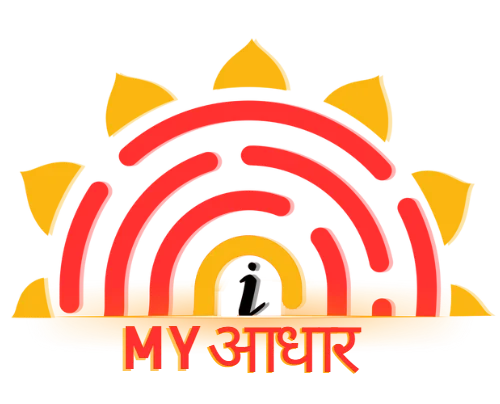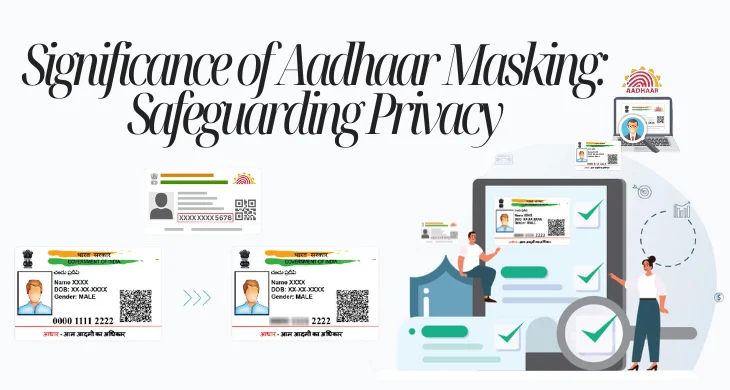In an era dominated by digital identities, the Masked Aadhaar has emerged as a pivotal tool for safeguarding privacy and security. This introduction unravels the intricacies surrounding Masked Aadhaar, delving into the measures designed to protect personal information and navigate the delicate balance between security and individual privacy. Join us on a journey to demystify the significance of Masked Aadhaar in an age where the protection of identity is paramount.
Understanding Aadhaar Masking:
In the realm of digital identity protection, Aadhaar Masking emerges as a valuable feature, providing individuals with the means to enhance privacy when accessing their e-Aadhaar. This feature allows users to conceal the majority of their Aadhaar number, mitigating the risk of unauthorized access while maintaining the document’s integrity.
When opting for Aadhaar Masking during the download of your e-Aadhaar, the first 8 digits of your Aadhaar number undergo a transformation. They are replaced with characters, typically represented as “xxxx-xxxx,” leaving only the last 4 digits visible. This intentional obscuring of the initial digits adds an extra layer of security, ensuring that sensitive information is not easily accessible to prying eyes.
It’s important to note that despite the masking of the Aadhaar number, the downloaded version retains access to crucial details such as your photograph, QR code, demographic data, and other pertinent information. Additionally, this version of your Aadhaar is signed by UIDAI, alleviating concerns about its acceptance and legibility in various situations. This masked version of Aadhaar proves particularly useful in scenarios where Aadhaar serves primarily as an identity proof. By providing the Aadhaar Masking along with the final four digits of the unique ID, individuals can efficiently authenticate their identity while minimizing the exposure of their Aadhaar number.
In essence, Aadhaar Masking is a proactive step towards bolstering the privacy of your digital identity. It offers a pragmatic solution for individuals who seek to balance the necessity of using Aadhaar as an identity proof with the imperative to safeguard sensitive information. As we navigate the digital landscape, features like Aadhaar Masking empower individuals with the tools needed to assert control over their privacy while seamlessly meeting identity verification requirements.
How to Obtain Aadhaar Masking: A Step-by-Step Guide for Enhanced Privacy
Step 1: Access the Official UIDAI Website
Visit the official UIDAI website at https://uidai.gov.in/ to initiate the process of obtaining Aadhaar Masking.
Step 2: Navigate to “Download Aadhaar”
Under the “My Aadhaar” tab, select the “Download Aadhaar” option to proceed with the download process.
Step 3: Choose a Method for Aadhaar Retrieval
Select one of the following methods based on your eligibility:
Method 1: Aadhaar Number
- Input your 12-digit Aadhaar number, full name, and pin code if you already possess an Aadhaar card.
Method 2: Enrollment Number
- If you don’t have an Aadhaar card, enter your full name, pin code, and the 28-digit enrollment number to download the card.
Method 3: Virtual ID
- For Aadhaar with Masking, input the 16-digit Virtual ID on the portal.
Step 4: Opt for Aadhaar Masking
Check the box next to the statement “I want Aadhaar Masking?” to ensure that your Aadhaar number is partially concealed.
Step 5: Request OTP
Choose “Send OTP,” and a one-time password (OTP) will be dispatched to the mobile number linked to your Aadhaar registration.
Step 6: Enter OTP
Enter the OTP received on your mobile to access your Aadhaar Masking. Alternatively, you can use the Time-Based OTP (TOTP) generated by the mAadhaar app by selecting the ‘Enter TOTP’ option.
Step 7: Download Aadhaar Masking
Your Aadhaar Masking will be downloaded, and it is advisable to keep it readily accessible for any future needs.
By following these steps, individuals can effortlessly obtain their Aadhaar Masking, ensuring an added layer of privacy when using Aadhaar for identity verification.
Government Mandate for Aadhaar Masking:
In response to growing apprehensions regarding the potential misuse of personal information during Aadhaar Card verification, the government has taken a decisive step to mandate the use of masked Aadhaar cards. This measure comes as a proactive response to safeguard the privacy of individuals and mitigate the risks associated with dishonest entities exploiting sensitive data. The inherent risk of unauthorized access and potential misuse of personal information during Aadhaar verification processes necessitated the implementation of stricter privacy measures. The masked Aadhaar card, with its concealed digits, serves as a formidable deterrent against malicious entities seeking to exploit vulnerabilities in the system.
By making masked Aadhaar cards mandatory, the government aims to instill a sense of security and confidence among citizens, assuring them that their personal information is being handled with the utmost care. This move aligns with the evolving landscape of digital privacy, emphasizing the government’s commitment to adapting and fortifying security measures in the face of emerging threats.
How Aadhaar Masking Mitigates Identity Fraud and Scams
Aadhaar Masking serves as a robust measure in preventing identity fraud and scams by strategically concealing sensitive information. This privacy-enhancing feature adds an extra layer of security to the Aadhaar card, significantly reducing the risk of unauthorized access and potential misuse.
- Key Security Measures: By masking the first 8 digits of the Aadhaar number and the QR code, Aadhaar Masking ensures that only the last 4 digits are visible. This deliberate obscurity plays a pivotal role in safeguarding against identity fraud, as it limits the exposure of critical information that could be exploited by malicious entities.
- Preventing Consumer Scams: Aadhaar Masking emerges as an effective tool in reducing consumer scams. By restricting the visibility of sensitive Aadhaar digits, individuals are less susceptible to scams that exploit personal information for fraudulent activities. This proactive approach aligns with the evolving landscape of digital security and consumer protection.
- Regulatory Mandates: The Reserve Bank of India (RBI) played a pivotal role in reinforcing the security framework. In May 2019, modifications to the master direction of Know Your Customer (KYC) regulations mandated that all RBI-regulated institutions adopt the Aadhaar eKYC online procedure. This directive, which includes the use of Aadhaar Masking, underscores the regulatory commitment to protecting consumers’ Aadhaar cards from potential risks and unauthorized access.
Essential Guidelines for Aadhaar Masking:
1. Masking Standards:
Adhering to Aadhaar Masking guidelines involves changing the first eight digits of the Aadhaar verification number to “XXXX XXXX,” leaving the final four digits unchanged. Additionally, the QR code is concealed. Legal and accessible, individuals can download the masked version securely through a password-protected electronic Aadhaar. Demographic details like name, date of birth (DOB), gender, and address remain unchanged throughout this process.
2. Digital Signature and Masking at Capture:
Under Aadhaar Masking guidelines, before being permanently stored, the Aadhaar information is masked at the point of capture. The process includes digital signatures by the Unique Identification Authority of India (UIDAI). This ensures the authenticity and security of the masked Aadhaar version, maintaining the integrity of the data.
3. Regulatory Oversight:
UIDAI governs Aadhaar, with regulatory oversight from various agencies such as RBI, IRDAI, TRAI, and SEBI. As per RBI regulations, any industry subject to RBI oversight must mask or blackout Aadhaar numbers during identification and onboarding processes. This requirement applies universally, irrespective of the industry or company size.
4. Mandatory Use of Masked Aadhaar:
According to RBI regulations, every company, regardless of its industry or size, must utilize a disguised Aadhaar. Even startups engaged in employer/customer identity verification are mandated to use a veiled version. This underscores the universal applicability of Aadhaar Masking across diverse business sectors.
5. Streamlining KYC Processes with AI:
Recognizing the need for efficient document management, especially in the banking and financial industries, Aadhaar Masking plays a vital role in streamlining the KYC process. As a frequently used document for various purposes, including bank account opening, insurance, FD, video KYC, and third-party onboarding, Aadhaar cards are subject to rigorous KYC procedures. Leveraging artificial intelligence (AI)-based technology is recommended for identifying and masking Aadhaar numbers in photos and videos, aligning with RBI-mandated KYC criteria. This automation accelerates the process while ensuring compliance and privacy.
In essence, following these Aadhaar Masking guidelines not only ensures compliance with regulations but also contributes to enhanced data security, customer privacy, and the seamless functioning of KYC processes across diverse industries.
Aadhaar Masking API:
The Aadhaar Masking API Solution, designed to meet UIDAI regulations, ensures adherence by masking both the initial 8 digits of the Aadhaar number and the QR code on Aadhaar cards. This robust solution empowers enterprises to securely store Aadhaar information while safeguarding the privacy of Aadhaar holders.
Faqs:
1. What is Masked Aadhaar?
Masked Aadhaar is a version of the Aadhaar card where certain digits of the Aadhaar number are partially masked or hidden to enhance privacy and security.
2. How does Masked Aadhaar enhance privacy?
Masked Aadhaar conceals a few digits of the Aadhaar number, displaying only the last four digits. This minimizes the risk of unauthorized access and protects sensitive personal information.
3. Is Masked Aadhaar an official and valid document?
Yes, Masked Aadhaar is an officially valid document. It holds the same validity as a regular Aadhaar card and can be used for various purposes, including identity verification.
4. Can I unmask the hidden digits if needed?
No, the hidden digits in Masked Aadhaar are permanently masked, and the unmasking option is not available. This ensures a higher level of security and prevents accidental exposure of sensitive information.
5. Can I use Masked Aadhaar for KYC (Know Your Customer) processes?
Yes, Masked Aadhaar is acceptable for KYC processes. It provides the necessary details for identity verification while offering an additional layer of protection.
Conclusion:
The significance of Aadhaar Masking extends far beyond a mere regulatory measure; it becomes a powerful tool for safeguarding individual privacy in the digital age. By strategically concealing the first 8 digits of the Aadhaar number and the QR code, this practice introduces an additional layer of security, mitigating the risks of identity fraud and scams.
Aadhaar Masking’s importance lies in its ability to empower individuals, providing them with control over the dissemination of sensitive information. As regulations, such as those mandated by the UIDAI and RBI, underscore the universal applicability of Aadhaar Masking across various industries, it becomes evident that this practice is integral to the evolving landscape of digital identity protection. By upholding privacy standards and incorporating Aadhaar Masking into identity verification processes, enterprises and regulatory bodies alike contribute to a more secure and trustworthy digital environment. The masked Aadhaar not only aligns with legal requirements but also reflects a commitment to respecting individual privacy rights.

